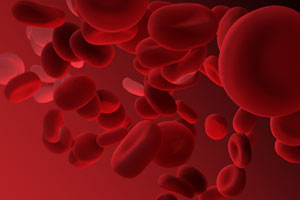 – Anemia is defined by a decrease in hemoglobin. This is a very common symptom in tropical areas where 10-20% of the population has Hb <10 g / dl.
– Anemia is defined by a decrease in hemoglobin. This is a very common symptom in tropical areas where 10-20% of the population has Hb <10 g / dl.
(Normal values:> 13 g / dl in men,> 12 g / dl in women,> 11 g / dL in pregnant women;
> 13.5 g / dL in the newborn; > 9.5 g / dl in children 2 to 6 months; > 11 g / dl in children 6 months to 6 years
> 11.5 g / dL in children 6 to 12 years.)
– Anaemia due to:
• defective red blood cell production: nutritional deficiencies in iron and / or folic acid, bone marrow depression, certain infections (HIV, visceral leishmaniasis, etc.);
• a loss of red blood cells s: acute or chronic bleeding (hookworm, etc.);
• increased destruction of red blood cells (haemolysis): malaria, infectious episodes or taking certain medications in patients with G6PD deficiency (primaquine, dapsone, cotrimoxazole, nalidixic acid, nitrofuran etc.) hémoglobulinopathie (sickle cell anemia, thalassemia) certain bacterial and viral infections (HIV).
– In tropical areas, the causes are often intertwined, are the two most common nutritional deficiency and malaria. The most at-risk groups are children and young women, especially during pregnancy.
– Anemia is not in itself an indication for transfusion. Most anemias are well tolerated and can be corrected by a simple etiological treatment.
Clinical signs:
– Common signs of anemia: pallor of the conjunctiva, the mucous membranes, palms of hands and soles of the feet;asthenia, dizziness, leg edema, dyspnea, tachycardia, heart murmur.
– Signs of severity involving the immediate prognosis: sweat, thirst, cold extremities, tachycardia, respiratory distress, shock.
– Look for signs of a specific pathology: cheilitis, glossitis due to nutritional deficiency, hemolytic jaundice, signs of malaria, etc.
laboratory:
– Hemoglobin (hematocrit default)
– Smear / thick film or quick test if suspected malaria
Treatment:
Iron deficiency anemia:
– Iron PO2 element for at least 2 months
Children under 2 years: 30 mg / day in 2 divided doses = 1/2 tab / day
Children from 2 to 12 years: 120 mg / day in 2 divided doses = 2 cp / day
Adult: 120 to 180 mg / day in 2 or 3 doses = 2-3 cp / day or better, give the element iron combination (65 mg) + folic acid (0.40 mg) PO based on the dosage of elemental iron.
– Associate an anthelmintic:
albendazole PO (except during the first trimester of pregnancy)
Children from 1 to 2 years: 200 mg single dose
Children over 2 years and adults: 400 mg single dose
or
mebendazole PO (except during the first trimester of pregnancy)
Children over one year and adults: 500 mg single dose
Acid folic deficiency anemia (rarely isolated):
– Folic acid PO
Children under one year: 0.5 mg / kg / once daily for 4 months
Children over one year and adults: 5 mg / once daily for 4 months
Hemolytic anemia:
– Malaria: iron is useless unless associated iron deficiency. For malaria treatment, see page 131.
– G6PD deficiency: no specific treatment; stop the suspected drug and early treatment of any infectious episode.
Severe anemia with bringing into play the immediate prognosis:
– Oxygen, especially in children.
– Transfusion after determination of the group, rhesus and HIV testing, hepatitis B and C, syphilis, malaria in endemic areas. To calculate the amount of blood to be transfused and calculating the rate of transfusion, see table on next page.
Note the prevalence of HIV infection makes its mandatory donor screening. With no possibility of screening, it is for the physician to balance the vital risk to the patient and transfusion risk. Transfusion is not formally indicated is strictly against inappropriate.
Monitoring of signs (pulse, blood pressure, respiratory rate, temperature) and clinical signs of transfusion reactions.
In some cases, especially in children with severe malaria, anemia may be responsible for heart failure. This may be decompensated by transfusion. If volume overload are signs: slow IV furosemide 1 mg / kg to a maximum of 20 mg / kg.
– Treating a lung infection or parasite (malaria) if present.
Prevention:
– Iron deficiency or folic acid:
• drug supplementation: elemental iron (65 mg) + folic acid (0.40 mg) PO
pregnant women: 60 to 120 mg / day in 1 or 2 doses = 1-2 cp / day
• Nutritional supplementation if the basic diet is insufficient
– In case of sickle cell disease: long-term treatment with folic acid PO: 5 mg / day.
– Early treatment of malaria, worm infections, etc.
